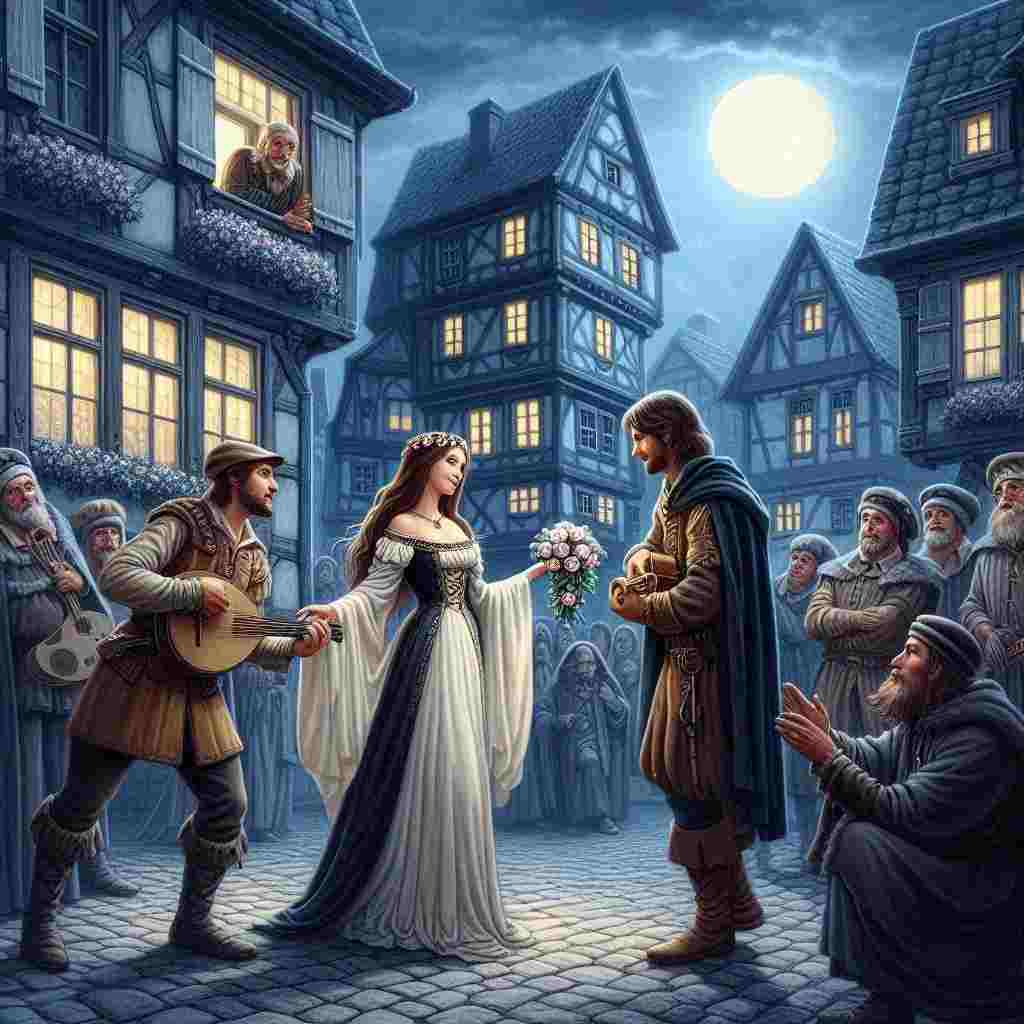The Miller's Tale
Richard

In Oxford town, a carpenter named John,
Had a young wife, Alisoun, fair as the dawn.
He doted on her, kept her locked away tight,
But love, like a miller's wheel, it grinds both day and night.
A scholar named Nick, a cunning young man,
Lived with John, with a stargazer's plan.
He lusted for Alisoun, a right merry dance,
This tale of deceit, a bawdy romance.
Nick, with his lute and voice like a song,
Charmed Alisoun, though to John she belonged.
He whispered of love, a forbidden delight,
While poor John the carpenter, snored through the night.
A student named Absalom, with locks flowing gold,
Also desired Alisoun, a story untold.
He joined in the plot, a love triangle's plight,
This tale of deceit, under the pale moonlight.
John, fearing a flood, by Nick's cunning tongue fooled,
Built three baskets, high in the rafters, so rude.
He planned to escape with Alisoun, you see,
While Nick and Absalom, climbed for a rendezvous, oh glee!
A jolly old parish clerk named Wally the wheeze,
Also fell for Alisoun, down on his knees.
He craved a hot meal, some company too,
This tale of deceit, just what will they do?
John climbed to the basket, a terrible crash,
As the rope snapped, leaving him hanging, aghast.
He bellowed for help, a flood's on its way!
But Alisoun and Nick, had a different game to play.
They tricked him with shouts, of a watery doom,
While Absalom climbed, for Alisoun's room.
Nick, with a hot poker, dealt him a blow,
This tale of deceit, getting out of control!
Wally the wheeze, climbed for a tasty treat,
But landed with Absalom, a comical feat.
John, still aloft, his anger did rise,
He cut down the baskets, with fury in his eyes.
The commotion awoke the whole town in a fright,
John, bruised and bewildered, exposed Nick's wicked plight.
Alisoun feigned innocence, a sly, wicked grin,
This tale of deceit, let the laughter begin!
The Miller's tale ends, with a lesson to learn,
Love and trickery, a fire that can burn.
So next time you court, with a heart full of glee,
Remember dear listener, what goes around, comes back to thee!
Richard's The Miller's Tale
"The Miller's Tale" is a vibrant and irreverent retelling of Geoffrey Chaucer's classic story from The Canterbury Tales, infused with a modern sensibility and a playful rhythm. This adaptation masterfully weaves together themes of love, lust, deception, and comeuppance, creating a tapestry of human folly that is both timeless and relatable.
The song opens by introducing the central characters: John, the naive carpenter; Alisoun, his young and alluring wife; and Nicholas, the cunning scholar. From the outset, the lyrics establish the tension between John's possessiveness and the inevitable force of desire, likening love to "a miller's wheel" that "grinds both day and night." This metaphor sets the tone for the unfolding drama, suggesting that passions, like the millstone, are relentless and transformative.
As the tale progresses, the cast of characters expands to include Absalom, the golden-haired student, and Wally the wheeze, the jolly parish clerk. Each man's pursuit of Alisoun adds layers of complexity to the plot, creating a farcical love pentagon that teeters on the edge of chaos. The repeated phrase "This tale of deceit" serves as a refrain, reminding listeners of the story's central theme while building anticipation for the inevitable unraveling of the characters' schemes.
The lyrics skillfully balance narrative progression with poetic imagery. Phrases like "under the pale moonlight" and "with locks flowing gold" lend a romantic quality to the proceedings, contrasting sharply with the bawdy nature of the events described. This juxtaposition of the sublime and the ridiculous mirrors the human condition, where our loftiest aspirations often collide with our basest instincts.
Humor plays a crucial role in the song, particularly in the description of John's misguided attempt to escape a non-existent flood. The image of the carpenter suspended in a basket, duped by his own gullibility, is both comical and poignant. It serves as a metaphor for the ways in which our fears and insecurities can lead us to absurd behaviors, leaving us vulnerable to manipulation by others.
The climax of the tale, with its confusion of identities and physical comedy, is rendered with gleeful abandon. The hot poker, the comical feat of Wally and Absalom, and John's furious descent from the rafters create a crescendo of chaos that resolves into a moment of clarity. The exposure of Nick's "wicked plight" and Alisoun's feigned innocence bring the deception full circle, leaving the characters to face the consequences of their actions.
The song concludes with a moral, echoing the traditional structure of fables and cautionary tales. However, the lesson here is delivered with a wink and a nod, acknowledging the cyclical nature of human follies. The final lines, "Remember dear listener, what goes around, comes back to thee!" serve as both a warning and a recognition of the universal nature of desire, deception, and their often humorous outcomes.
In reimagining "The Miller's Tale," the songwriter has created a piece that celebrates the enduring appeal of Chaucer's work while making it accessible to a contemporary audience. The song's rollicking rhythm and clever rhymes make the complex web of relationships and deceits easy to follow, inviting listeners to laugh at the foibles of others while perhaps recognizing a bit of themselves in the characters' all-too-human motivations.
Ultimately, "The Miller's Tale" as presented in this song is a celebration of storytelling itself. It revels in the joy of a well-spun yarn, the timeless appeal of love and lust, and the universal pleasure we take in seeing pomposity and selfishness receive their comeuppance. In doing so, it reminds us that while the details of our lives may change, the core of human nature—with all its glorious imperfections—remains eternally, and entertainingly, the same.
This text was generated by AI and is for reference only. Learn more
Want to join the discussion? Reopen or create a unique username to comment. No personal details required!



Comments
No comments yet. Be the first to comment!